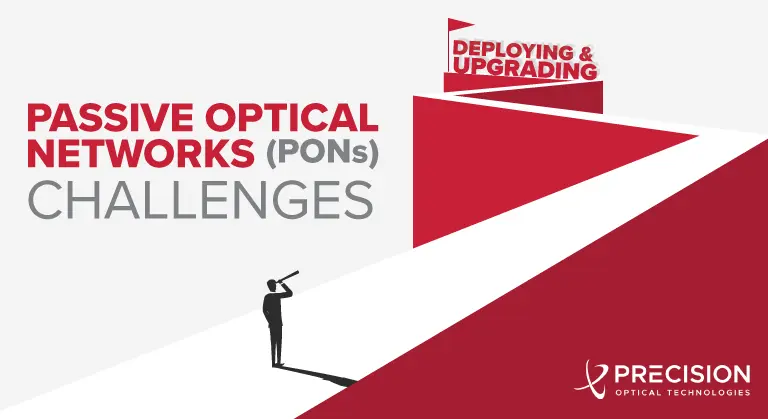
Challenges in Deploying and Upgrading Passive Optical Networks (PONs) in 2024

Happy New Year to all our readers! At last, 2024 is upon us and that means it’s time to get back to brass tacks about your network infrastructure goals. Given that the Passive Optical Network (PON) market is expected to grow from its current valuation of USD $13.76 billion to USD $35.59 billion by 2030, we wanted to start the year off strong by talking about how you can speed and simplify your PON deployments this year.
To start with, let’s talk about the challenges network operators are facing regarding PON deployments and upgrades right now. We’ve gone ahead and put together a list of 4 key issues that Multiple System Operators (MSOs), service providers and other access network operators are facing right now.
1.) Demand for Bandwidth and Greater PON Scalability
Subscriber demand for cloud gaming, 4K/8K TV, smart home technology, distance education and work-from-home solutions is driving service providers to accelerate investments in PON technology. An Omdia survey, for example, found that 80% of cable operators will be deploying PON networks of some type by the spring of 2024. Already 35% of MSOs have successfully deployed PON in their networks, with another 47% expected to do so in 2024. As we venture into 2024, these operators must grapple with the task of designing and deploying PON architectures as quickly and efficiently as possible – all with an eye to ensuring scalability for future expansions and technology upgrades. This necessitates a forward-thinking approach to network architecture and technology selection.
2.) PON Equipment Procurement and Customization Challenges
In the realm of equipment procurement, network operators face multiple challenges, often stemming from vendor-lock. From extended lead times and higher equipment costs to hassles with equipment configuration/integration and support in case there’s a need to leverage equipment from outside the proprietary system, vendor-lock creates difficulties for service providers. We talk about this further in a previous blog on PON networks and the closed, turnkey PON systems network operators have been facing. Fortunately, thanks to greater MSO, service provider and access network operator interest in white box technology and more open ecosystems, times are changing in their favor. Every network operator knows best what they need and rightly should have the freedom to design, implement and customize their architecture as needed, free from prescriptive, vendor-locked solutions. After all, it’s 2024!
3.) Keeping up with the Joneses: Technology Evolution and Compatibility
The rapid evolution of PON technologies, such as the transition from Gigabit PON (GPON) to symmetrical 10G PON (XGS-PON), introduces significant complexities to the deployment of PON architectures. Network operators must consider factors like population density, geographic location, whether the deployment is brownfield or greenfield, and provider/customer requirements in terms of bandwidth, quality of service and redundancy. They must also consider the fact that PON design is highly dependent on optical link budget. While link budgets vary by PON type and ODN class, network operators must consider optical specifications, split ratios, link distance and other existing elements like splices, connectors, and distribution panels to stay within max loss budget parameters (i.e., 29 dB is often a ballpark loss budget for XGS-PON for Class N1/N2). It takes a high level of technical expertise to implement a PON network, let alone transition from GPON to XGS-PON. In this case, careful planning is vital to ensure seamless integration of new technologies with existing infrastructure.
4.) Tight Economic Conditions
In our tighter economic landscape, network operators need the ability to do more with what they currently have. Here, service convergence and resource optimization (i.e., reuse of existing ODN/passive resources) are vital. Successfully converging residential, commercial, and wireless services over a single infrastructure while leveraging existing resources can speed time-to-market and decrease expenditures relative to vendor-locked solutions. Vendor-lock funnels network operators into specific hardware and software choices that may or may not be exactly what is needed, draining capital and thus potentially prolonging deployment timelines.
Simplifying and Speeding PON Deployments with OpenPath™
As network operators navigate the complexities of deploying and upgrading their PONs in 2024, we’ve developed a new kind of end-to-end PON Access Solution called OpenPath™. This comprehensive, turnkey solution was purpose-built to make deploying PON networks simpler, more efficient and more flexible for MSOs, service providers and other access network operators. Leveraging a white box hardware model, OpenPath™ will lower lead times and mitigate the multiple barriers to entry that many network operators face, such as the ones discussed in this post. Covering all the critical components of a PON network, including Optical Line Terminals (OLTs), optics, splitters, Optical Network Units (ONUs) and cutting-edge controller software, our solution can make all the difference for your PON goals in 2024 and beyond.
For more information on OpenPath™, visit our website and contact one of our experts!






